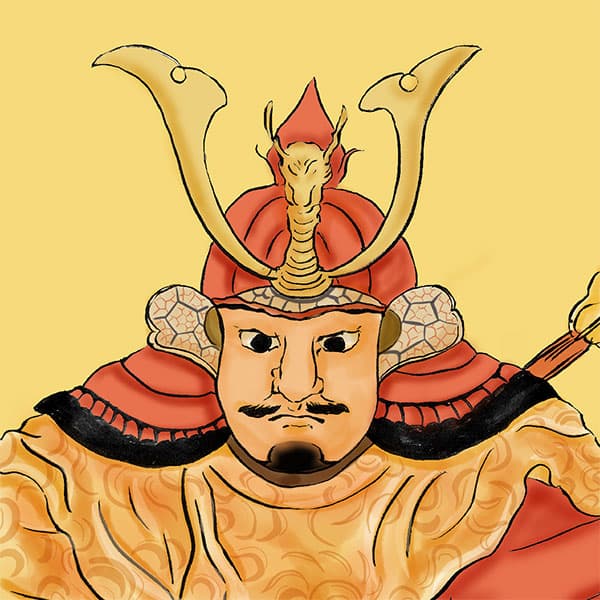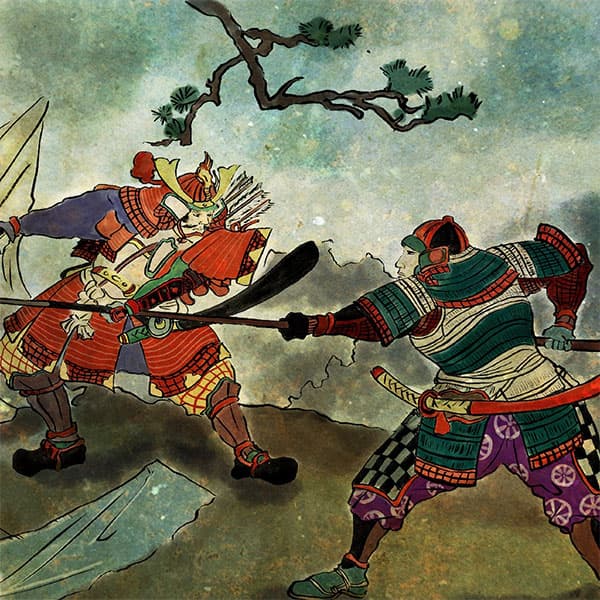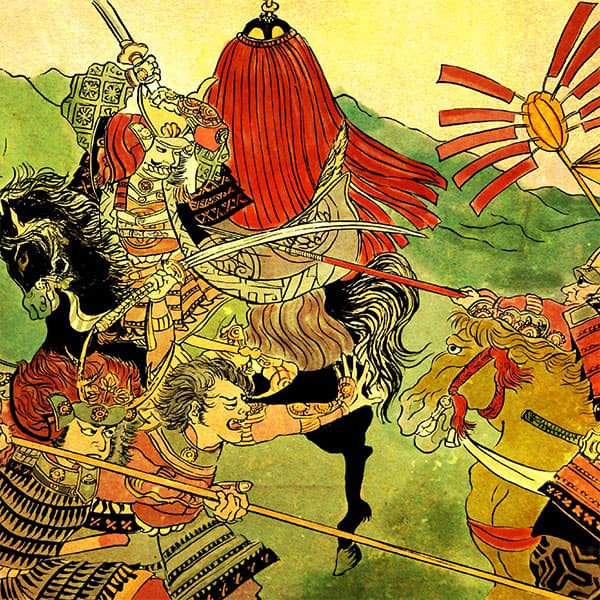Yoshimoto Imagawa (2/2)The best bowman on Kaido

Yoshimoto Imagawa
- Article category
- biography
- name
- Yoshimoto Imagawa (1519-1560)
- place of birth
- Shizuoka Prefecture
- Related castles

Sunpu Castle
- related incident
In 1560, Yoshimoto Imagawa led his army and began an invasion of Nagono Castle in Owari Province. In order to save Odaka Castle (present-day Otaka, Midori Ward, Nagoya City), which was under pressure from the Oda family, he forced the Mikawa samurai to take over the Oda family's fort.
After receiving news of the auspicious victory in the preliminary battle, Yoshimoto, who had been waiting at Kutsukake Castle, moved his main body forward. However, while resting at Okehazama on the way, he was attacked by Oda Nobunaga, and although he fought bravely with his vassals, he was defeated by the Oda family's vassals. He passed away at the age of 42.
Imagawa soldiers tried to take Yoshimoto's decapitated body back to Sunpu, but Yoshimoto's body decomposed more rapidly than expected and was buried in Mikawa National Treasure Ii District.
The head that had been killed by the Oda side was later returned to Suruga through negotiations between Nobunaga and Yoshimoto's senior vassals who remained in Narumi Castle and fought hard.
Portrait of Yoshimoto Imagawa
Yoshimoto Imagawa was known as ``the best bowman on the coast of Japan.'' Kaido refers to Tokaido. Yumitori refers to those who fight with bows and arrows, and thus refers to ``samurai'', which in turn refers to ``kunimochi daimyo''. In the late Muromachi period, Imagawa Yoshimoto and Tokugawa Ieyasu were called by this nickname. Although his nickname suggests that he is a representative of a samurai family, the image of Yoshimoto is reminiscent of the appearance of a court noble.
Yoshimoto was raised as a monk from an early age and had lived in Kyoto growing up, so he had an understanding of the culture of the capital. For this reason, they protected court nobles who had fled from the capital, and adopted the fashions of the capital and utilized them in their governance. This tendency is common to the Ouchi family in Suo Province and the Asakura family in Echizen Province.
Moreover, because he himself wore black teeth, eyebrows, and light makeup like a court noble, he is said to have indulged in aristocratic tastes. However, there is also a theory that this story is a later creation. Furthermore, even if it were true, it would indicate the high status of the samurai family, which is allowed only to those above the shugo daimyo level.
For example, Yoshimoto is said to have ridden a lacquered palanquin, but in the Muromachi shogunate, the lacquered palanquin was a vehicle only allowed to the highest rank of the shogunate, the sobanshu. Samurai on horseback were considered a symbol of authority because there was a rule that they must dismount whenever they met on the street.
Yoshimoto was a strong man who tried to use these cultures and formalities to govern and stabilize the people of Tokaido through the Hanakura Rebellion regarding family succession and the subsequent feuds with the Hojo and Oda families. It may have been.
Places related to Yoshimoto Imagawa
- Imagawa Yoshimoto bronze statue
- It was built on the north side of JR Shizuoka Station in 2020 to commemorate the 500th anniversary of Yoshimoto Imagawa's birth.
Yoshimoto Imagawa, dressed in armor, was instrumental in the development of the Tokaido region today, including the separation of nations, the development of gold mines, and the construction of highways, reminding us of the glory of days gone by. - Rinzaiji Temple
- Rinzaiji Temple is located in Aoi Ward, Shizuoka Prefecture. This temple was built by Taihara Sessai, a military commander of Yoshimoto Imagawa, as a family temple for Yoshimoto's older brother, Ujiteru Imagawa, the 8th head of the family. Ujiteru improved the Imagawa family's organization and established Umawarishu. He also focused his efforts on promoting commerce, contributing to the rise of the Imagawa family and the development of the Tokaido Road.
- Kiyomizu temple
- This is a temple located in Aoi Ward, Shizuoka City. It was originally the site of a Shingon Esoteric Buddhism school that was opened during the era of Yoshimoto's father, Ujichika Imagawa. According to the will of his older brother Ujiteru, Yoshimoto ordered Motonaga Asahina to build it in 1559, and it was named Otowa-san Kiyomizu-dera because it resembled the scenery of Kiyomizu-dera in Higashiyama, Kyoto. Masu.
- Okehazama Battlefield
- Okehazama Battlefield is located in Midori Ward, Nagoya City, Aichi Prefecture. The old battlefield of Okehazama, said to be the last place of Yoshimoto Imagawa, has been maintained and is now a place of relaxation for the citizens as Okehazama Battlefield Park.
- Yoshimoto Tomb
- Yoshimoto Tomb, located in Okehazama Battlefield Park, is the tombstone of Yoshimoto Imagawa, erected in 1934 (Showa 9).
- Okehazama Battlefield Monument
- The Okehazama Battlefield Monument was raised from the bed of the Kurarasegawa River in the early Showa period. The last year was the 13th year of Bunka (1816), and the front of the stone tablet reads ``Okehasama Battlefield,'' and the back says ``Heiko Gogatsu Ken, 13th Bunka.''
Imagawakan and Sunpu Castle
In the 14th century, the Imagawa clan, who were appointed as the guardians of Suruga by the Muromachi shogunate, built Imagawa-tate on this land and made it the center of their dominion. In 1536, when the Hanakura Rebellion occurred, Yoshimoto Imagawa became the lord of Suruga Province and the lord of Imagawa-kan. However, when Yoshimoto Imagawa was killed in the Battle of Okehazama, the alliance between the Imagawa family and the Takeda family was dissolved, and in 1568, when Takeda Shingen invaded Suruga, Imagawa Ujima served as the lord of the castle. Imagawa-kan will disappear.
Tokugawa Ieyasu, who later came to rule Suruga Province, built Sunpu Castle on the site of Imagawa-date. Sunpu Castle was built as a castle in the early modern period, and a castle tower was constructed.
In the early Edo period, Sunpu Castle was used as a retirement place by the retired Tokugawa Ieyasu, and was extensively renovated by feudal lords from all over the country. As a result, its current form, a contour-style flat castle with a triple moat, was completed. However, just after its completion in 1607, the year Ieyasu moved to Sunpu Castle, an accidental fire destroyed the Honmaru Palace. However, reconstruction work began the following year and was completed in 1610. After Ieyasu's death, it functioned as the center of Suruga Province under the direct control of the Edo Shogunate.
One-third of the outer moat of the current Mie moat has been reclaimed and no longer exists, and the site where Sannomaru once stood has become an urban area with public facilities such as government offices and schools located there. The middle moat still exists, but some of the stone walls have collapsed due to past earthquakes and are now resembling earthworks. In addition, the site where Ninomaru and Honmaru used to be is open to the public as ``Sunpu Castle Park.''
In 1989, Tatsumi Yagura was restored as a commemorative project for the city's 100th anniversary, and in 1996, the East Gate and Tsukitamon Yagura were restored using traditional construction methods. The inside is a museum that you can tour. Also, the Hitsuji Saru Yagura was restored at the end of March 2014.
Sunpu Castle currently exists as a place of relaxation for citizens, and its appearance gives people a sense of the long history of Suruga Province.
Reread Yoshimoto Imagawa's article
- related incident

- WriterTomoyo Hazuki(Writer)I have loved history and geography since my student days, and have enjoyed visiting historical sites, temples and shrines, and researching ancient documents. He is especially strong in medieval Japanese history and European history in world history, and has read a wide range of things, including primary sources and historical entertainment novels. There are so many favorite military commanders and castles that I can't name them, but I especially like Hisashi Matsunaga and Mitsuhide Akechi, and when it comes to castles, I like Hikone Castle and Fushimi Castle. Once you start talking about the lives of warlords and the history of castles, there's a side of you that can't stop talking about them.





